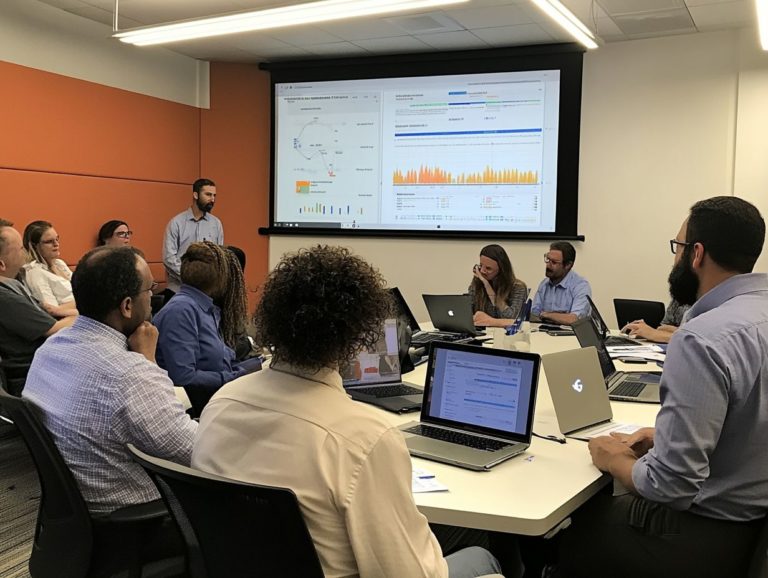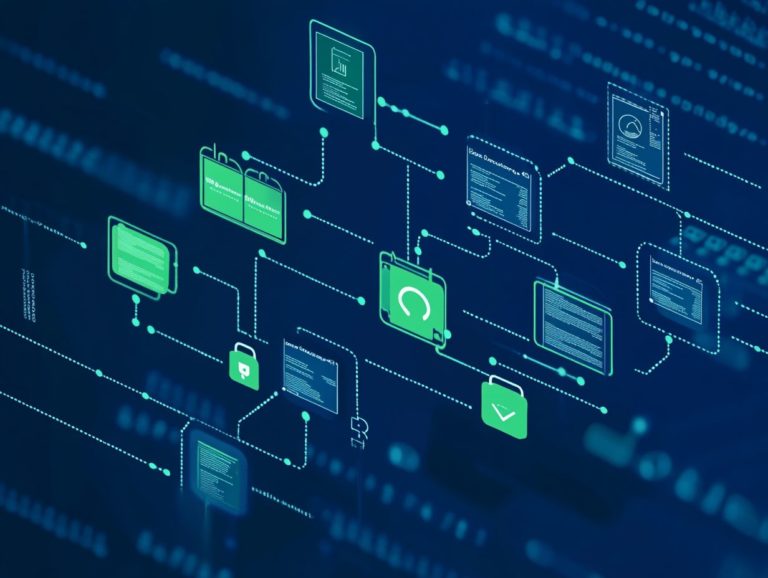how vulnerability assessments improve cyber hygiene
In today’s digital landscape, maintaining robust cybersecurity is more crucial than ever. Central to this effort is the concept of cyber hygiene, which encompasses the practices and habits that protect your systems from threats.
One effective way to enhance your cyber hygiene is through vulnerability assessments. These assessments identify weaknesses in your infrastructure and guide you in implementing essential changes to fortify your defenses.
This article delves into the significance of cyber hygiene, defines vulnerability assessments, and offers best practices for conducting them. This ensures that your organization remains resilient against cyber threats.
Contents
Key Takeaways:

Vulnerability assessments are crucial for improving cyber hygiene by identifying weaknesses and potential risks in a system or network. Understanding the importance of continuous improvement in vulnerability assessment can significantly enhance overall cyber hygiene and reduce the risk of cyber attacks. Conducting regular assessments and following best practices can help maintain strong cyber hygiene and ensure the security of sensitive data and systems.
The Importance of Cyber Hygiene
Cyber hygiene is crucial for keeping your data safe! With the surge of cyber threats, data breaches, and increasingly sophisticated cyberattack campaigns, it becomes essential to adopt effective practices.
This practice involves a comprehensive approach to minimizing vulnerabilities. It ensures your IT infrastructure remains resilient against potential attacks and fosters a culture of employee awareness through training.
By implementing robust cyber hygiene measures, you can significantly enhance your organization s risk assessment capabilities. You can also streamline compliance requirements and ultimately safeguard your data.
This proactive stance protects your valuable information while preserving stakeholder trust and ensuring operational efficiency.
Defining Cyber Hygiene
Cyber hygiene embodies the practices and measures you employ to ensure the integrity, confidentiality, and availability of your organization s information systems and data.
By implementing comprehensive security policies, you establish frameworks that clearly define protocols for data handling and access controls. These policies should be tailored to address specific threats, focusing on identifying risks and prioritizing them.
Employee awareness training is important in cultivating a security-conscious culture. It enables your staff to remain vigilant against cyber threats like phishing attacks and malware.
Together, these elements safeguard sensitive information and ensure that every individual within your organization recognizes their role in maintaining a secure digital landscape.
Why it Matters for Cybersecurity

Understanding the significance of cyber hygiene is vital for you and your organization. It strengthens your defenses against the ever-evolving landscape of sophisticated cyber threats and data breaches.
By cultivating a robust set of practices, you can dramatically enhance your incident response capabilities while effectively managing vulnerabilities.
Regularly updating software, implementing rigorous password policies, and conducting frequent security audits allow you to take a proactive stance. This mitigates risks and fosters a culture of security awareness among your employees.
Cyber hygiene is key to establishing a continuous defense mechanism, giving your organization the power to identify and address weaknesses before they become exploitable.
Ultimately, a steadfast commitment to these hygiene practices can elevate your organization s overall security posture, rendering it more resilient against potential attacks.
Understanding Vulnerability Assessments
Vulnerability assessments are thorough evaluations designed to identify, classify, and prioritize vulnerabilities within your organization s IT infrastructure.
These assessments play a vital role in effective vulnerability management and are integral to your overall risk assessment strategies.
What is a Vulnerability Assessment?
A vulnerability assessment and the cybersecurity framework is key to boosting your cyber hygiene! It helps you identify, quantify, and prioritize vulnerabilities within your system, providing insights to enhance your security level.
This process unfolds through a series of structured steps, starting with asset discovery and risk analysis. Then, you ll employ specialized tools and methodologies, including automated scanners and manual assessments.
The goal isn t just to pinpoint weaknesses; it s about understanding their implications for your organization’s risks. By integrating threat intelligence, you can contextualize vulnerabilities against potential attack vectors, significantly improving the accuracy of your assessment.
With a clear picture in hand, you can initiate targeted remediation efforts. This may involve patch management, configuration tweaks, or implementing robust security controls ultimately leading to a stronger defense against emerging threats.
Types of Vulnerabilities Assessed

Vulnerability assessments encompass various types of vulnerabilities, drawing insights from both internal and external scans each playing a unique yet complementary role.
Internal scans uncover vulnerabilities within your own network. This process examines critical elements like system configurations, outdated software, and insufficient security protocols. The insights gained reveal potential weaknesses that could be exploited by insiders or malicious software.
On the other hand, external scans probe your organization s perimeter, identifying threats from the outside. This includes spotting open ports, exposed services, and misconfigured firewalls.
Together, these assessments are crucial for effective patch management. They empower your team to prioritize and apply updates efficiently, enhancing your overall cybersecurity posture and significantly reducing the risk of data breaches.
How Vulnerability Assessments Improve Cyber Hygiene
Vulnerability assessments are essential for elevating your organization’s cyber hygiene. By systematically identifying weaknesses and risks, you empower yourself to make informed remediation efforts and improve your security practices, especially when considering the benefits of continuous vulnerability assessment.
This proactive approach not only strengthens your defenses but also fosters a culture of vigilance within your organization.
Identifying Weaknesses and Risks
The process of vulnerability assessments is crucial for pinpointing weaknesses and potential risks within your organization s IT infrastructure. This makes it essential for proactive threat detection and management.
By systematically evaluating your systems and applications, you uncover not only known vulnerabilities but also emerging threats that could lead to significant data breaches. This proactive approach allows you to prioritize remediation efforts, ensuring that the most critical vulnerabilities are addressed promptly.
Vulnerability assessments enhance your ability to protect sensitive information, reinforcing trust with clients and stakeholders. The insights gained from these assessments lay the groundwork for developing robust security policies, strengthening defenses, and promoting continuous improvement in your cybersecurity practices.
Start your vulnerability assessment today and take the first step toward a secure future!
Implementing Necessary Changes

Implementing necessary changes from your vulnerability assessment is vital to boost your cyber hygiene. This includes effective fixes, diligent patch management, and updated security policies.
After the evaluation, prioritize the most critical vulnerabilities that pose risks. Start by categorizing them based on severity and potential impact.
Once you’ve done that, you can start fixing the issues. This may include configuring firewalls, updating software, and correcting system misconfigurations.
Effective patch management is key. Ensure that updates and security patches are applied promptly to both software and hardware.
Embracing automated patching can streamline the process, reduce downtime, and minimize human error.
Regularly reviewing these measures is necessary. It helps adapt to the evolving threats you face.
Best Practices for Conducting Vulnerability Assessments
Adhering to best practices for conducting vulnerability assessments is crucial for your organization. By following these guidelines, you can effectively identify and mitigate risks, ensuring compliance with regulatory requirements while maintaining a robust security posture.
Steps to Conducting a Successful Assessment
Conducting a successful vulnerability assessment requires a series of meticulously defined steps, including a comprehensive risk assessment, prioritization of vulnerabilities, and effective communication of findings through automated reports.
To embark on this essential process, begin with a thorough evaluation of your organization s assets and potential threats. This stage involves identifying critical systems, data repositories, and network components that require protection.
Next, risk assessment takes center stage. Here, vulnerabilities are systematically analyzed based on their potential impact and likelihood of exploitation. By concentrating on the most pressing issues, you can prioritize fixing the problems efficiently.
It s also crucial to communicate these findings clearly to stakeholders, including technical teams and management. This fosters a security-focused culture and ensures that resources are allocated effectively to mitigate risks.
Tools and Resources for Assessing Vulnerabilities
Utilizing the right tools and resources for assessing vulnerabilities is essential for conducting effective vulnerability assessments. This approach enables you to automate processes and generate comprehensive reports that shape your security strategies.
By using advanced technologies such as automated scanners, real-time monitoring software, and integrated threat intelligence platforms, you can systematically identify potential weaknesses in your systems.
Many of these tools come equipped with features like customizable reporting options, prioritization of vulnerabilities based on risk levels, and collaboration capabilities that enhance communication among security teams. Adopting these resources has significant advantages: you ll enjoy enhanced efficiency, reduced manual overhead, and quicker responses to identified threats.
With automated reporting, stakeholders can swiftly grasp your security posture, empowering them to make well-considered choices and foster a proactive approach to cybersecurity.
Frequently Asked Questions
What does a vulnerability assessment do for your security?
A vulnerability assessment is a process of identifying, quantifying, and prioritizing vulnerabilities in a system, network, or application. It helps improve practices that keep computer systems safe and secure by identifying and addressing potential security weaknesses before they can be exploited by malicious actors.
How often should vulnerability assessments be conducted?
Don’t wait! Ideally, vulnerability assessments should be conducted regularly, at least once a year, or whenever major changes are made to the system. This ensures that any new vulnerabilities are quickly identified and addressed, helping to improve overall cyber hygiene.
What are the benefits of regular vulnerability assessments?
Regular vulnerability assessments are crucial for keeping your systems secure! They can identify and address vulnerabilities before they are exploited, help prioritize security updates and patches, and provide valuable insights for enhancing overall security measures.
What common vulnerabilities can be identified?
Vulnerability assessments can identify a wide range of vulnerabilities, including software flaws, misconfigured systems, weak passwords, lack of encryption, and outdated software or hardware. Understanding the benefits of cross-organization vulnerability assessments is essential to improve cyber hygiene.
How do vulnerability assessments contribute to regulatory compliance?
Many industries are required to comply with specific regulations for protecting sensitive data. Regular vulnerability assessments help ensure these requirements are met and demonstrate a commitment to maintaining secure computer practices.
Can vulnerability assessments be automated?
Yes! Vulnerability assessments can be automated and integrated into existing security processes, making them more efficient and less time-consuming. This allows for more frequent and comprehensive assessments, leading to a stronger and more robust cybersecurity posture.
Start your vulnerability assessment today to protect your assets!






